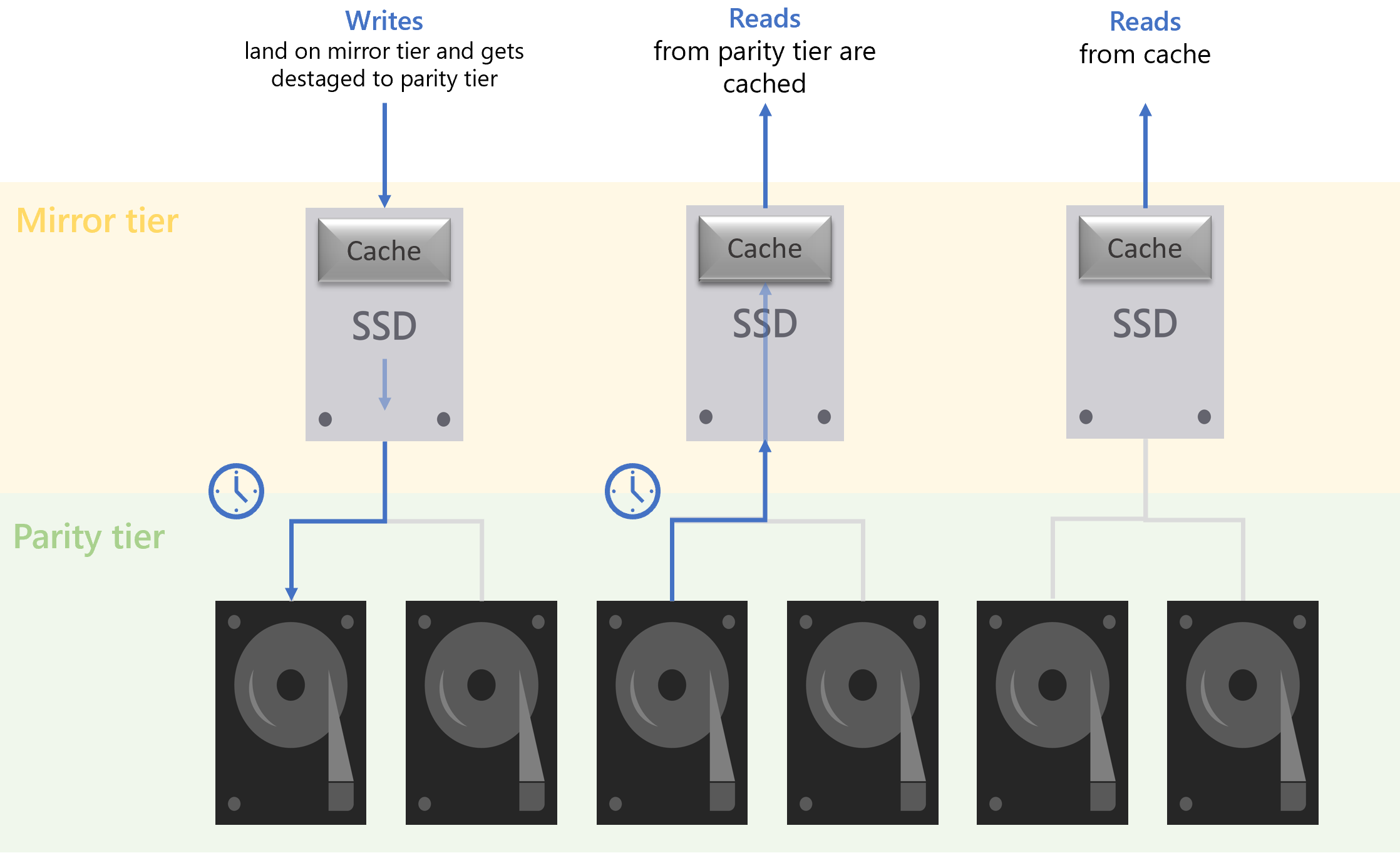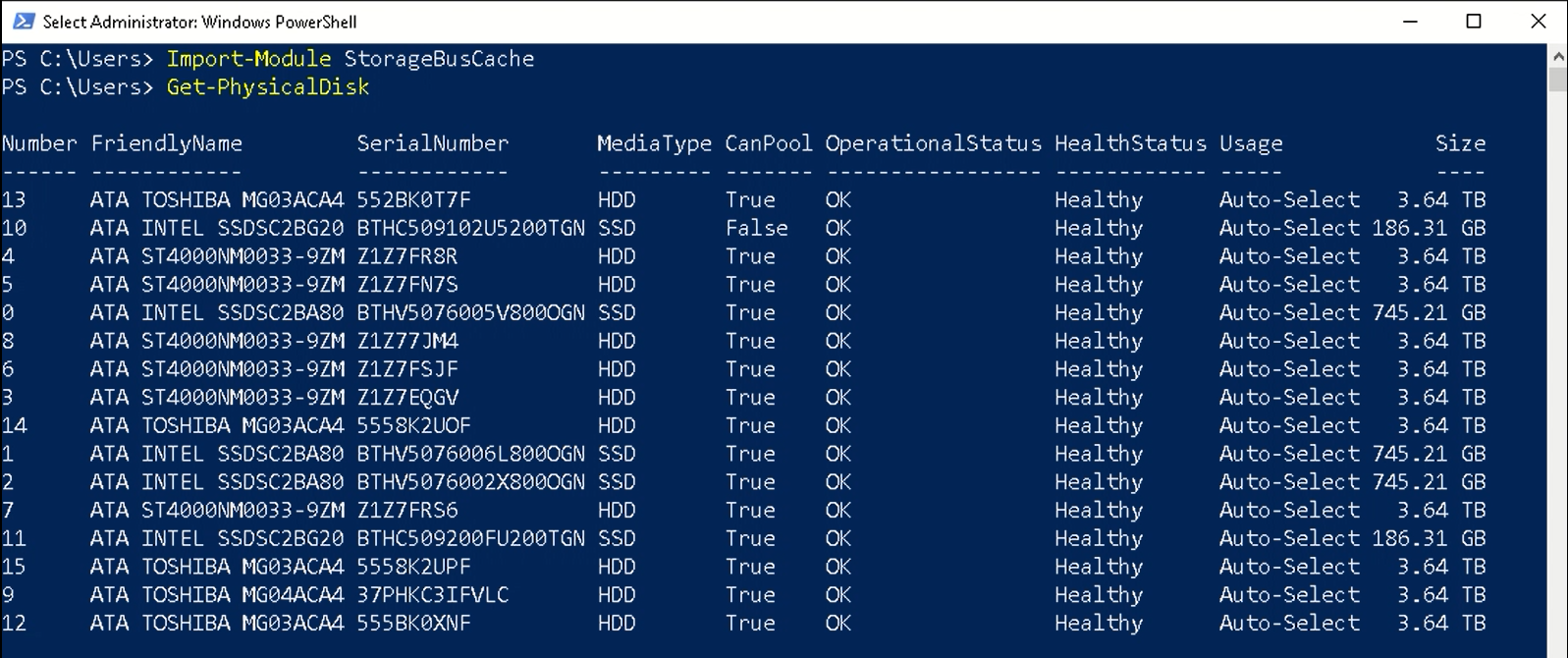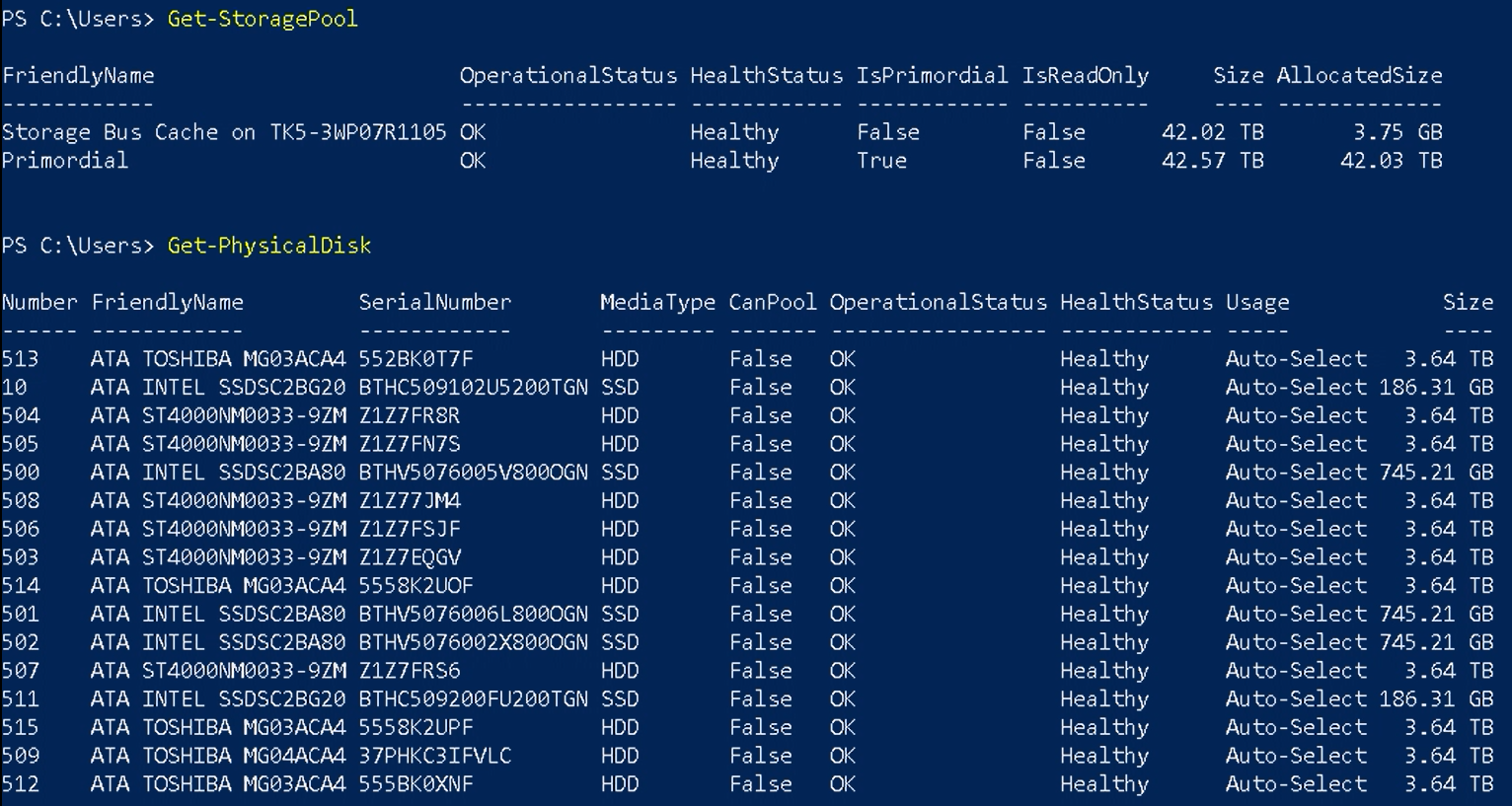Not
Åtkomst till denna sida kräver auktorisation. Du kan prova att logga in eller byta katalog.
Åtkomst till denna sida kräver auktorisation. Du kan prova att byta katalog.
Lagringsbusscachen för fristående servrar kan avsevärt förbättra läs- och skrivprestanda, samtidigt som lagringseffektiviteten bibehålls och driftskostnaderna hålls nere. Den här funktionen binder samman snabbare media (till exempel SSD) med långsammare media (till exempel HDD) för att skapa nivåer. Mer information finns i Förstå lagringspoolens cacheminne. Som standard är endast en del av den snabbare medienivån reserverad för cachen.
| Resiliency | Cachetyp |
|---|---|
| Ingen (enkelt blanksteg) | Läsning och skrivning |
| Spegla accelererad paritet | Read |
Om systemet inte kräver återhämtning eller har externa säkerhetskopior stöder lagringsbusscachen både läs- och skrivcachelagring. För motståndskraftiga system fungerar lagringsbusscachen endast som en läscache, och du bör välja ReFS(Resilient File System) Speglingsaccelererad paritet som volymåterhämtning. Den här kombinationen förbättrar prestanda för slumpmässig läsning eftersom data läses från paritetsnivån och cachelagras på den snabbare speglingsnivån. Speglingsnivån tillhandahåller även funktioner för skrivcachelagring om etableringsläget är inställt på Delad (standard).

I den här handledningen lär du dig:
- Vad lagringsbussens cacheminne är
- Så här aktiverar du lagringsbusscachen
- Hantera cachen efter distributionen
Prerequisites
 Du bör överväga lagringsbusscachen om din miljö matchar alla följande egenskaper
Du bör överväga lagringsbusscachen om din miljö matchar alla följande egenskaper
- Din server kör Windows Server 2022; och
- Din server har 2 media-/enhetstyper, varav en måste vara HDD (till exempel: SSD+HDD eller NVMe+HDD); och
- Funktionen Failover Clustering är installerad på servern
 Du kan inte använda Storage Bus-cacheminnet om din miljö matchar någon av följande egenskaper
Du kan inte använda Storage Bus-cacheminnet om din miljö matchar någon av följande egenskaper
- Servern kör Windows Server 2016 eller 2019. eller
- Din server har en helt flash-konfiguration; eller
- Servern är medlem i ett failover-kluster
Note
Den här funktionen kräver att servern har funktionen Failover Clustering installerad, men servern kan inte vara en del av ett failover-kluster.
Funktionsöversikt
I det här avsnittet beskrivs vad varje konfigurerbart fält i lagringsbusscachen är och tillämpliga värden.
Get-StorageBusCache
När det inte är aktiverat bör utdata likna följande exempel:
ProvisionMode : Shared
SharedCachePercent : 15
CacheMetadataReserveBytes : 34359738368
CacheModeHDD : ReadWrite
CacheModeSSD : WriteOnly
CachePageSizeKBytes : 16
Enabled : False
Note
För allmänt bruk bör du använda standardinställningarna. Eventuella ändringar måste göras innan du aktiverar lagringsbusscachen.
Etableringsläge
Det här fältet avgör om den snabbare medienivån, eller bara en del av den, används för cachelagring. Det här fältet kan inte ändras när du har aktiverat lagringsbusscachen. Etableringsläget har två alternativ:
- Delad (standard): Cachen tar bara upp en del av den snabbare medienivån. Den exakta procentandelen kan konfigureras i fältet Procent för delad cache.
- Cache: Dedikera det mesta av den snabbare medienivån till cachelagring i stället för bara en del. Mer information finns i Förstå lagringspoolens cacheminne.
Procent för delad cache
Det här fältet gäller endast när Etableringsläge är inställt på Delat. Standardvärdet är 15%och fältet kan ställas in från 5% till 90%. Du bör inte använda ett värde över 50% när du använder speglingsaccelererade paritetsvolymer eftersom det måste finnas en balans mellan cachen och speglingsnivån.
Enabled
Det här fältet refererar till tillståndet för lagringsbussens cacheminne och kan antingen vara sant eller falskt.
Avancerade fält
Important
Ändringar i dessa fält rekommenderas inte. Det går inte att göra justeringar efter att du har aktiverat lagringsbusscachen.
Byte för reserv av cachemetadata: Mängden diskutrymme (i byte) som är reserverat för Lagringsutrymmen. Det här fältet används endast om etableringsläget är cache.
Hårddisk i cacheläge: Standardinställningen är att tillåta att enheter med hårddiskkapacitet cachelagrar läsningar och skrivningar. För enkla blanksteg kan den här inställningen ställas in på ReadWrite eller WriteOnly.
SSD-läge för cacheminne: Det här läget är för framtida bruk när alla blixtsystem stöds. Standardinställningen är att endast tillåta att enheter med SSD-kapacitet cachelagrar skrivningar.
Cache-sidans storlek KBytes: Det här fältet kan ställas in på 8, 16 (standard), 32 och 64.
Aktivera lagringsbusscache i PowerShell
Det här avsnittet är en steg-för-steg-guide om hur du aktiverar lagringsbusscachen för din fristående server i PowerShell.
Importera modulen.
Import-Module StorageBusCacheKonfigurera cacheinställningar för lagringsbussen.
Du bör använda standardinställningarna. Om du gör det hoppar du över det här steget för att fortsätta med standardvärdena.
Important
Om konfiguration krävs gör du det innan du aktiverar lagringsbusscachen. Se avsnittet Funktionsöversikt för mer information om fälten.
Kontrollera enhetens status.
Get-PhysicalDiskUtdata bör likna följande bild, där kolumnen Number visar värden under 500 och CanPool-kolumnen visar true för alla icke-startenheter.

Aktivera cachelagring av bussar.
Enable-StorageBusCacheDet här steget kommer att:
- Skapa en lagringspool med alla tillgängliga enheter.
- Bind det snabba och långsamma mediet och bilda cachen.
- Lägg till lagringsbussens cache med standardinställningar eller anpassade inställningar.
Du kan köra
Get-StoragePoolför att se namnet på lagringspoolen ochGet-PhysicalDiskigen för att se effekterna av att aktivera lagringsbusscachen. Utdata bör likna följande bild. Kolumnen Nummer visar värden över 500, vilket anger att lagringsbussen gjorde anspråk på enheten. Kolumnen CanPool visar nu False för alla icke-startenheter. Om är inställt påProvisionModeCache innan du aktiverar visas kolumnen Användning som Journal för de snabbare enheterna.
Kontrollera lagringsbussens cachetillstånd.
Kontrollera att fälten är korrekta och att fältet Aktiverad nu är inställt på sant.
Get-StorageBusCacheUtdata bör likna följande exempel:
ProvisionMode : Shared SharedCachePercent : 15 CacheMetadataReserveBytes : 34359738368 CacheModeHDD : ReadWrite CacheModeSSD : WriteOnly CachePageSizeKBytes : 16 Enabled : True
När lagringsbusscachen har aktiverats är nästa steg att skapa en volym.
Skapa en volym
Vilken volym du ska skapa beror på om du skapar volymen med eller utan återhämtning.
Volymer med återhämtning
Följande PowerShell-cmdlet skapar en speglingsaccelererad paritetsvolym på 1 TiB med ett Mirror:Parity-förhållande på 20:80, vilket är den konfiguration som du bör använda för de flesta arbetsbelastningar. Mer information finns i Speglingsaccelererad paritet.
New-Volume –FriendlyName "TestVolume" -FileSystem ReFS -StoragePoolFriendlyName Storage* -StorageTierFriendlyNames MirrorOnSSD, ParityOnHDD -StorageTierSizes 200GB, 800GB
Volymer utan återhämtning
Följande PowerShell-cmdlet skapar en enkel volym på 1 TB som inte tolererar diskfel. Cachelagring av både läsning och skrivning stöds.
New-Volume -FriendlyName "TestVolume" -FileSystem ReFS -StoragePoolFriendlyName Storage* -ResiliencySettingName Simple -Size 1TB
Gör ändringar när du har aktiverat lagringsbusscachen
När du har kört Enable-StorageBusCachegår det inte att ändra sidstorleken Etableringsläge, Delad cacheprocent, Reservbyte för cachemetadata, HDD för cacheläge, SSD för cacheläge och Cache. Begränsade ändringar kan göras i den fysiska inställningen. Mer information finns i följande vanliga scenarier.
Lägga till eller byta ut kapacitetsenheter (HDD)
När enheten har lagts till manuellt kör du följande cmdlet för att slutföra intagningsprocessen.
Update-StorageBusCache
Lägga till eller ersätta cacheenheter (NVM:er eller SSD:er)
Det finns ingen cmdlet för att avbinda/binda om befintliga bindningar och balansera relationen. Följande steg gör att den befintliga läscachen går förlorad.
Remove-StorageBusBinding
New-StorageBusBinding
Kontrollera och balansera cache- och kapacitetsbindningarna
Använd följande cmdlet för att kontrollera befintliga cache- och kapacitetsbindningar.
Get-StorageBusBinding
I följande exempel visar den första kolumnen kapacitetsenheter och den tredje kolumnen visar de cacheenheter som de är bundna till. Följ instruktionerna när du lägger till eller byter ut cacheenheter för att säkerställa att de gamla cacheenhetstilldelningarna rensas innan nya konfigureras. Om du hoppar över det här steget kan systemet hindra systemet från att använda de gamla cachetilldelningarna, vilket kan störa uppnåendet av en balanserad konfiguration.

Vanliga frågor och svar om cachelagring av lagringsbuss
I det här avsnittet får du svar på vanliga frågor om lagringsbusscachen på Windows Server 2022.
Varför måste funktionen för redundansklustring installeras när servern inte är en del av ett kluster med växling vid fel?
Den här funktionen är utformad för fristående servrar men bygger på SBL-cachen (Storage Bus Layer) för Lagringsutrymmen Direct. Funktionen för redundansklustring måste installeras eftersom klustringskomponenter behövs.
Kommer lagringsbussens cacheminne att fungera med en helt flash-konfiguration?
Nej, den här funktionen fungerar bara när det finns två medietyper, varav den ena måste vara hårddisk. Den här funktionen fungerar inte med RAID-, SAN- eller flashsystem.
Hur kan cacheinställningarna för lagringsbussen ändras?
Se följande exempel för att ändra etableringsläget från Delad (standard) till Cache. Standardinställningar rekommenderas och alla ändringar bör göras innan lagringsbussens cacheminne aktiveras.
Set-StorageBusCache -ProvisionMode Cache